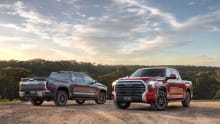
Industry slams Luxury Car Tax adjustment that will see more 'green' cars slapped with taxes
As part of the federal government’s Mid Year Economic and Fiscal...
Browse over 9,000 car reviews
.jpg)
The rotary engine has largely fallen out of favour with many car brands, but Mazda is determined to make the internal combustion technology work despite its obvious shortcomings.
While the last mass-market production rotary sports car was retired with the RX-8 more than a decade ago in 2012, Mazda continued to develop the engine technology and has recently resurrected the rotating-triangle powertrain for use in its MX-30 SUV as a range extender.
But the brand isn't done with the rotary just yet, as Mazda Motor Corporation Oversight Director of R&D, Ichiro Hirose, simply responded with a definitive "yes" when asked by CarsGuide at the 2023 Japan Mobility Show if we can expect further developments of the fan-favourite engine.
And when questioned as to why a relatively small brand like Mazda would continue to pour time and money into developing a niche engine like the rotary, Hirose smiled and simply said: "Because it's only Mazda who does it."
Clearly, the rotary engine is important to Mazda, which has been pioneering the technology since the 1967 Cosmo Sport.
Mazda's efforts have seen it produce two million rotary engines since then, but what does the brand have in store next for the powertrain found under the bonnets of legendary cars like the RX-7 coupe, Le Man-winning 787B and short-lived Furai?

The Iconic SP concept at this year's Japan Mobility Show is the most obvious pointer, as it uses a rotary range-extending electric powertrain, capable of punching out 272kW and can be fed with hydrogen and other clean fuels.
Bear in mind, this isn't the first instance of a hydrogen-powered rotary engine either, as Mazda produced a small batch of dual-fuel RX-8s known as the Hydrogen RE that could travel up to 100km on the clean fuel, emitting only water vapour.
CarsGuide put it to Hirose that the Iconic SP had more of a resemblance to an RX-7 sports car with its pop-up headlights, fixed-roof coupe design and rotary powertrain than a future MX-5 – like many have speculated.
"Partially, it may look like an MX-5 and partially, I think it looks like an RX-7 as well – so that's all I can say," he said.

Hirose also explained that the Iconic SP concept's powertrain takes the MX-30's rotary range-extending plug-in hybrid premise – a naturally aspirated 830cc unit that powers a 17.8kWh battery, feeding into a 125kW/259Nm electric motor – but kicks it up a few notches.
"With MX-30, we introduced RE-V, which is a compact, high-output engine, so taking advantage of that... what can we make for a sports car?" he said.
"That's something we have in the [Iconic SP] concept."

And though Hirose wouldn't be drawn on the production chances of the Iconic SP concept, Mazda is exploring electrification options for its next-generation 'NE'-series MX-5 roadster, and a further refinement of this powertrain would allow the Hiroshima brand to reduce tailpipe emissions, electrify the iconic nameplate and keep weight down.
Finally, while Mazda is once again producing rotaries for the MX-30, no examples will make it to Australia as the slow-selling nameplate has now been discontinued, leaving the R-EV plug-in hybrid variant exclusively for European and Japanese markets.










Comments